How dirty is your car?
This study was conducted by webuyanycar, the UK’s go-to online car-buying service and car valuation experts. If you’d like to use the visuals or data from the study, please credit webuyanycar with a link.
Get a free valuation
Findings from our recent survey have shown that 3 in 4 (73%) people in the UK spend more than 30 minutes in their car daily - equivalent to spending more than a whole week each year sitting in the car. This makes it all the more important to keep your space clean, ensuring your environment is both comfortable and safe while on the road.
From steering wheels held throughout an entire journey to gear sticks handled every time you shift, a car’s interiors are a perfect example of high-contact areas in need of regular cleaning. However, with everyday use, hygiene maintenance can sometimes slip from the mind.
With many of the UK's cars washed at commercial car washes, the outside may shine after the occasional trip, but the inside? That’s where crumbs, splashes, and those mysterious stains often live rent-free. Unlike the mud on your tyres, the bacteria inside are much harder to spot…unless you bring in a microbiologist with a swab!
We decided to find out exactly what’s lurking in our everyday vehicles by swabbing 10 used cars, targeting the gear sticks, door handles, steering wheels, and seatbelt buckles, to find out just how dirty the cars were, and which areas are the worst offenders. Here’s what we discovered.
Key findings
-
The gearstick had the highest average viable count at ~40 CFU/cm²*.
-
Some gearsticks spiked above 100 CFU/cm², showing how a lack of regular cleaning can allow bacteria to accumulate over time.
-
Next were the inside door handle (~33 CFU/cm²), steering wheel (~22 CFU/cm²) and seatbelt buckle (~19 CFU/cm²).
-
Inside door handles also reached similar peaks (~119 CFU/cm²), but the gearstick remained dirtiest on average in our samples.
-
Colonies were consistent with common environmental/skin bacteria. Presumptive IDs (culture-based) included Bacillus spp., Escherichia coli (coliform-like colonies) and Serratia marcescens.
*Counts are expressed as CFU/cm² (viable microorganisms capable of forming a colony, per square centimetre).
The worst offenders - and the bacteria we found
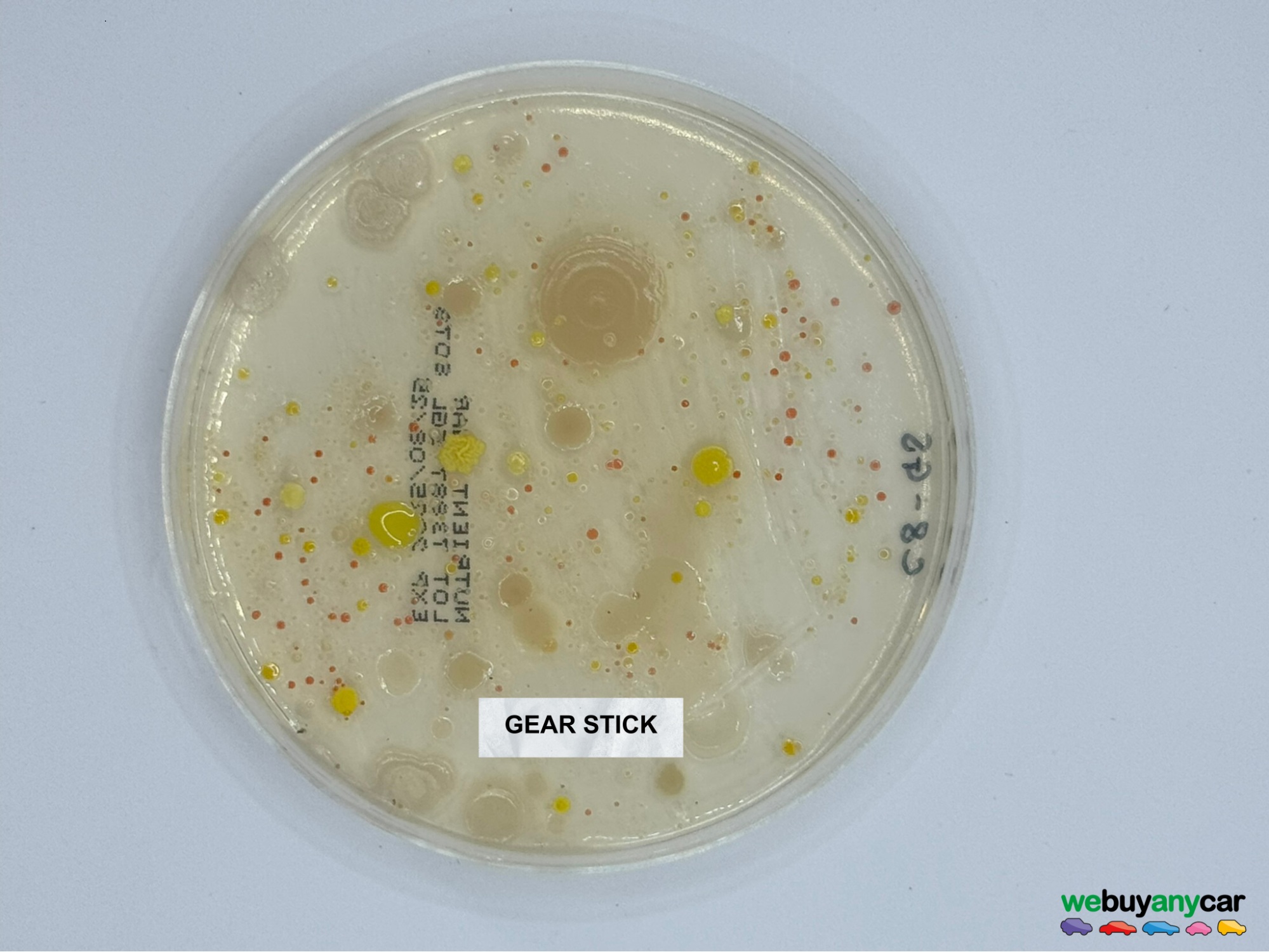
When it came to bacteria levels, the gear stick left the competition in the dust (and crumbs). Our swab samples revealed it had the highest CFU/cm² of any area tested, with 40 live microorganisms, meaning it’s officially the dirtiest part of the car.
Gear sticks often have stitched leather or textured rubber grips, which create micro-environments, perfect for bacterial harbourage. Some gear sticks spiked above 100 CFU/cm², showing how a lack of regular cleaning can allow bacteria to accumulate significantly over time. No other car surface in the study reached these levels consistently, so while this area might not look dirty, microbiologically, it’s often the most neglected surface in your car.
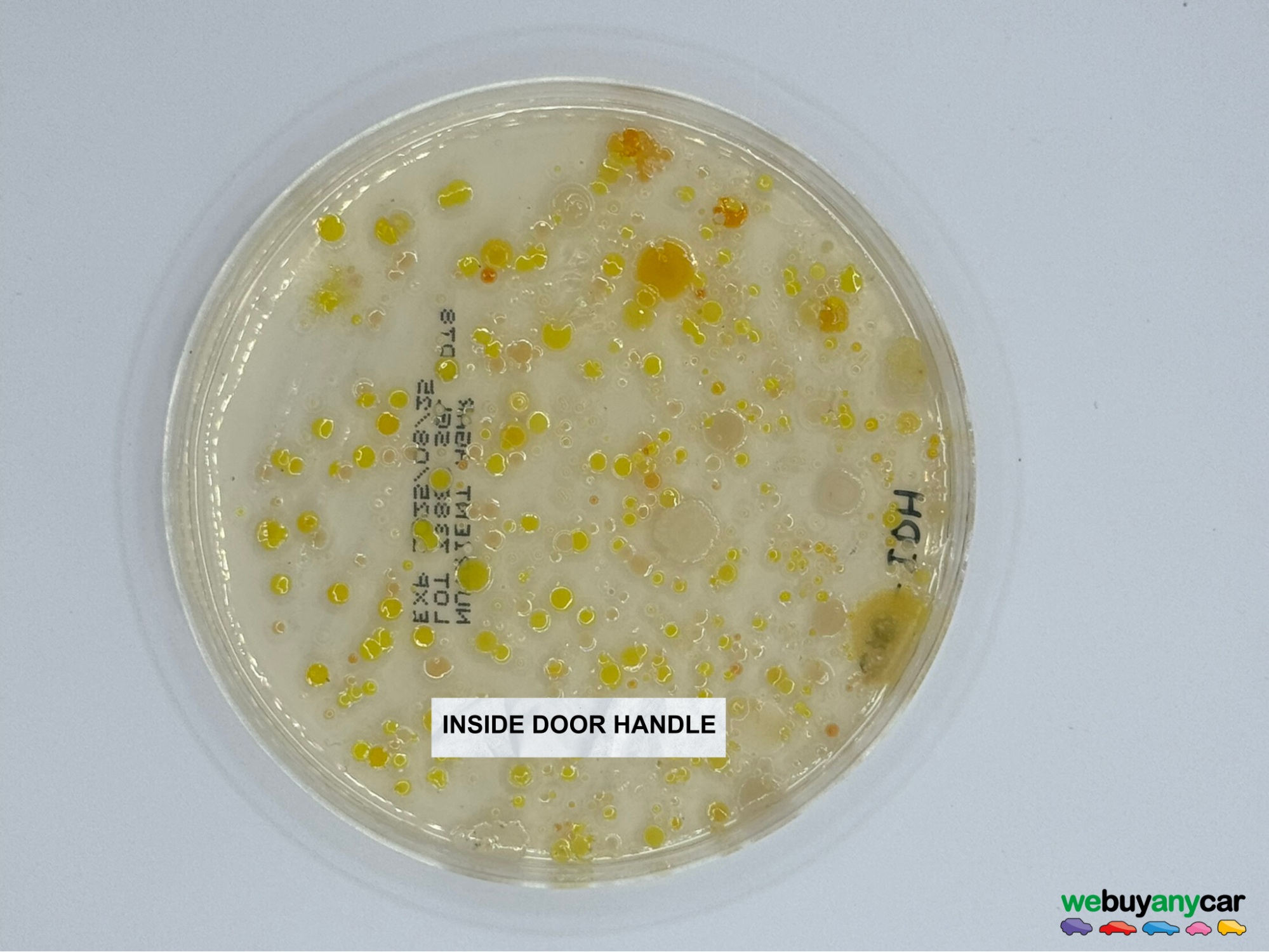
Ranking as the second-dirtiest area was the interior door handle, which, on average, was home to 33 live microorganisms. It’s perhaps unsurprising, considering how often we touch it when getting in and out of the car multiple times a day. This was, however, just one of two areas where E. coli was found present, which comes from gut bacteria and is usually faecal.
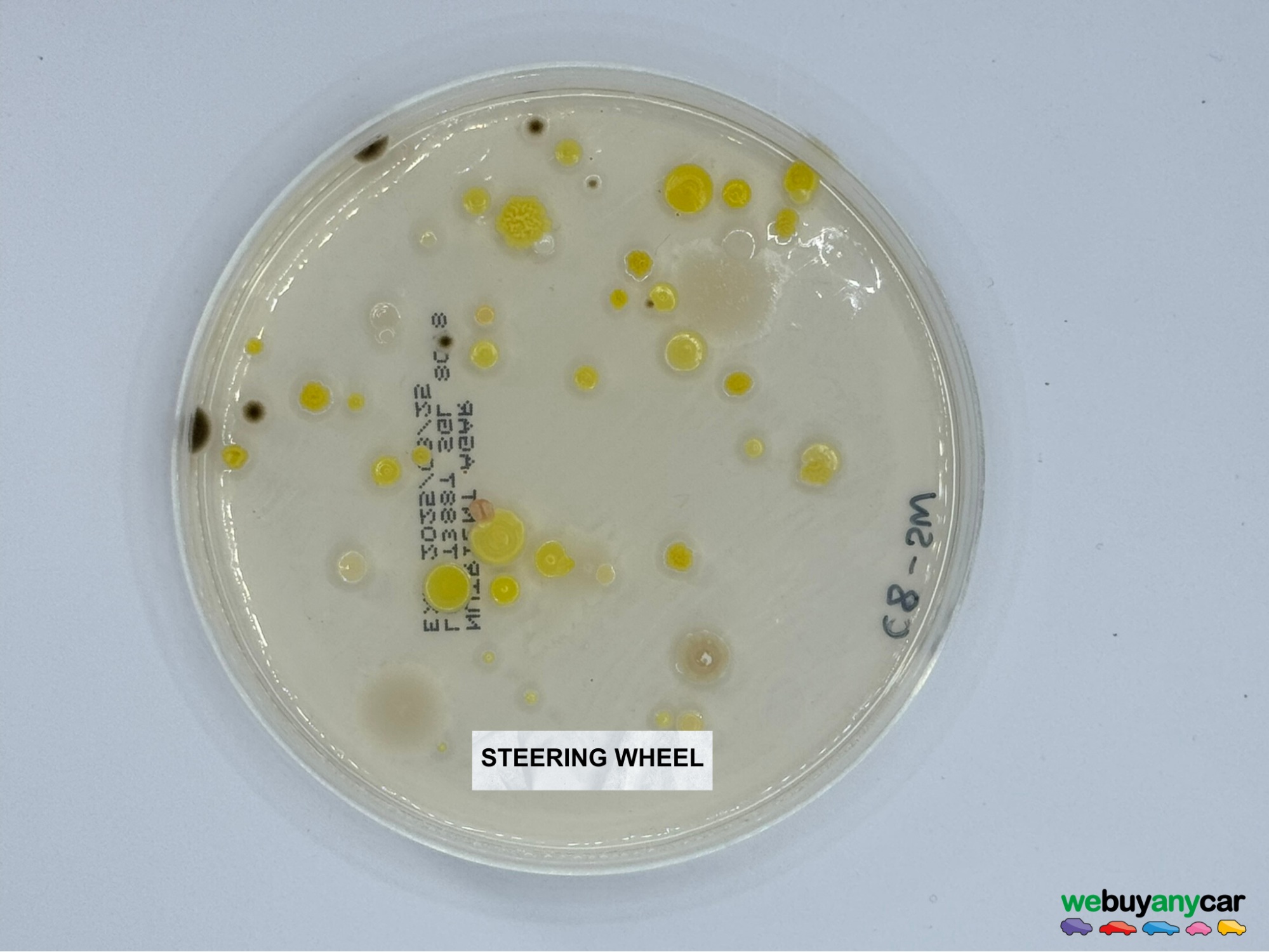
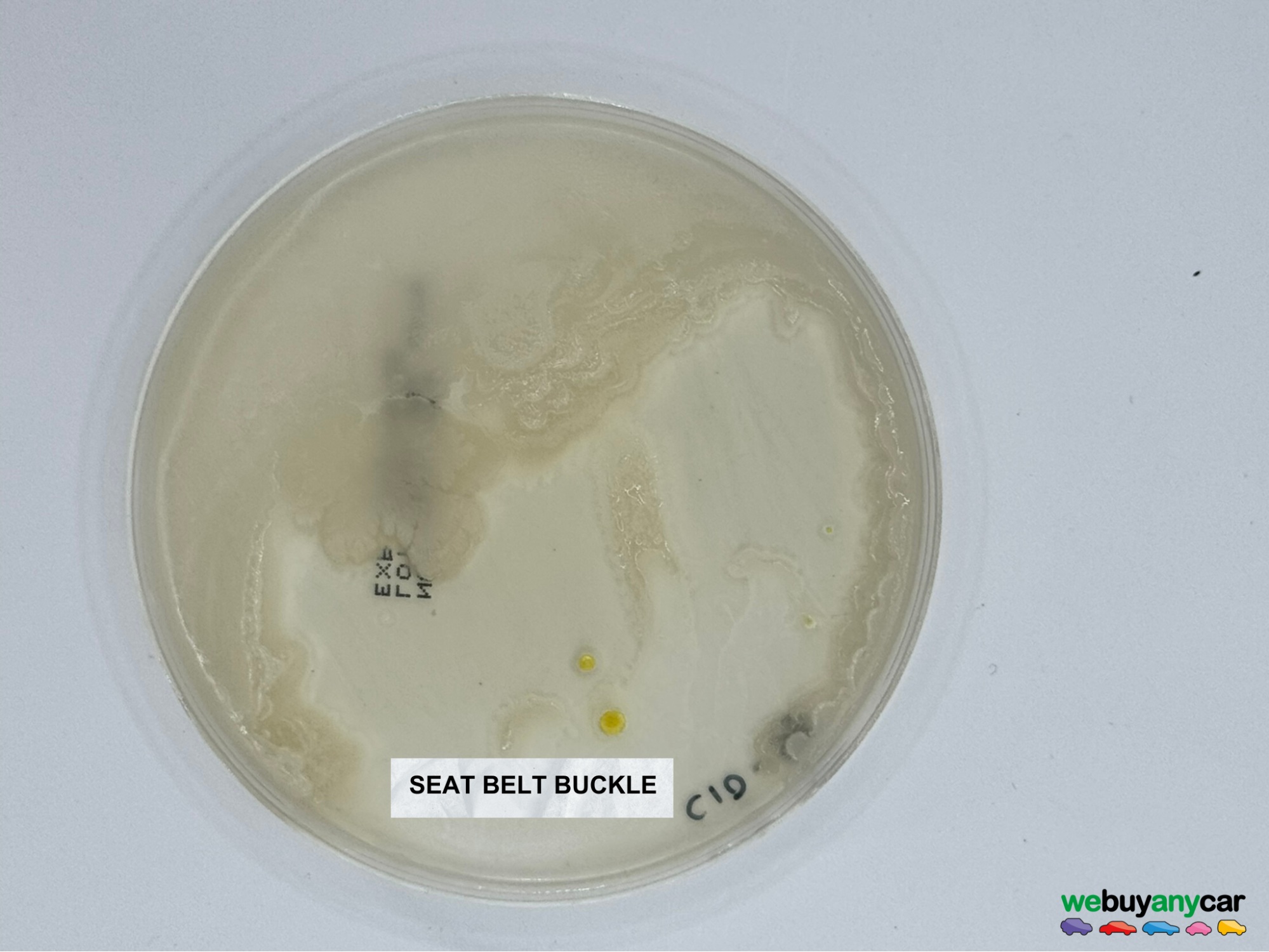
Following these were the steering wheel (22 CFU/cm2) and seatbelt (19 CFU/cm2). While the seatbelt ranked as the ‘cleanest’ area of the car tested, this also tested positive for Enteric bacteria (including E. coli).
What are the dangers of these bacteria?
Bacillus species
Their spores are tough and can survive dry, harsh environments for a long time, which is why they linger on surfaces. B. subtilis is mostly harmless, but B. cereus can cause food poisoning if ingested. Commonly found in soil, dust, and on plant surfaces.
Staphylococcus
S. epidermidis was frequently seen, likely from hands on various areas tested throughout the vehicles. Cars can be warm and often a bit humid, so it makes sense that they survive well.
While usually harmless on the skin, they can be problematic if they get into wounds or for people with weakened immune systems. These can usually be found on human skin, mucous membranes, and in the nose.
Micrococcus luteus
This bacterium lives on our skin and in the air. It thrives in dry, dusty places. It’s not usually dangerous, but in rare cases it can cause infections in immunocompromised people. Mainly found on human skin, dust, and in soil.
Serratia marcescens
If it’s in a car, there’s likely been spilt drinks, high humidity, or damp upholstery. It’s classed as an opportunistic pathogen and can cause infections in wounds, the urinary tract, or the lungs. These bacteria can be found in damp environments, water, and bathroom surfaces.
Pseudomonas species
In our samples, P. aeruginosa is the most concerning, as it’s highly resistant to antibiotics and causes serious infections in hospitals. In cars, the risk is low unless you’ve got open wounds, but it still suggests poor hygiene or leftover moisture. These are usually found in soil, water, and moist hospital environments.
Enteric bacteria (e.g. E. coli, Klebsiella, Proteus)
These are gut bacteria (faecal, found in the intestines of humans and animals), and some strains can cause food poisoning. The main risk is transferring these bacteria from the surface to the mouth, like eating food that’s dropped on the seat. Their presence is a solid hygiene red flag.
Moulds (e.g. Aspergillus niger, Cladosporium, Penicillium)
While mould doesn’t usually harm healthy people, its spores can trigger allergies or asthma, especially Cladosporium, which is known to be a respiratory irritant. Mould also damages upholstery and creates a musty smell. These are often found in soil, decaying vegetation, and indoor air.
Yeasts (e.g. Candida spp., Rhodotorula mucilaginosa)
Candida is part of normal human flora. Rhodotorula is more environmental and thrives in sugary, moist spots like spilt drinks. They can be found on skin, mucous membranes, and in food environments. Both are opportunistic; they can cause infections, but mainly in immunocompromised people.
How often do we clean our cars?
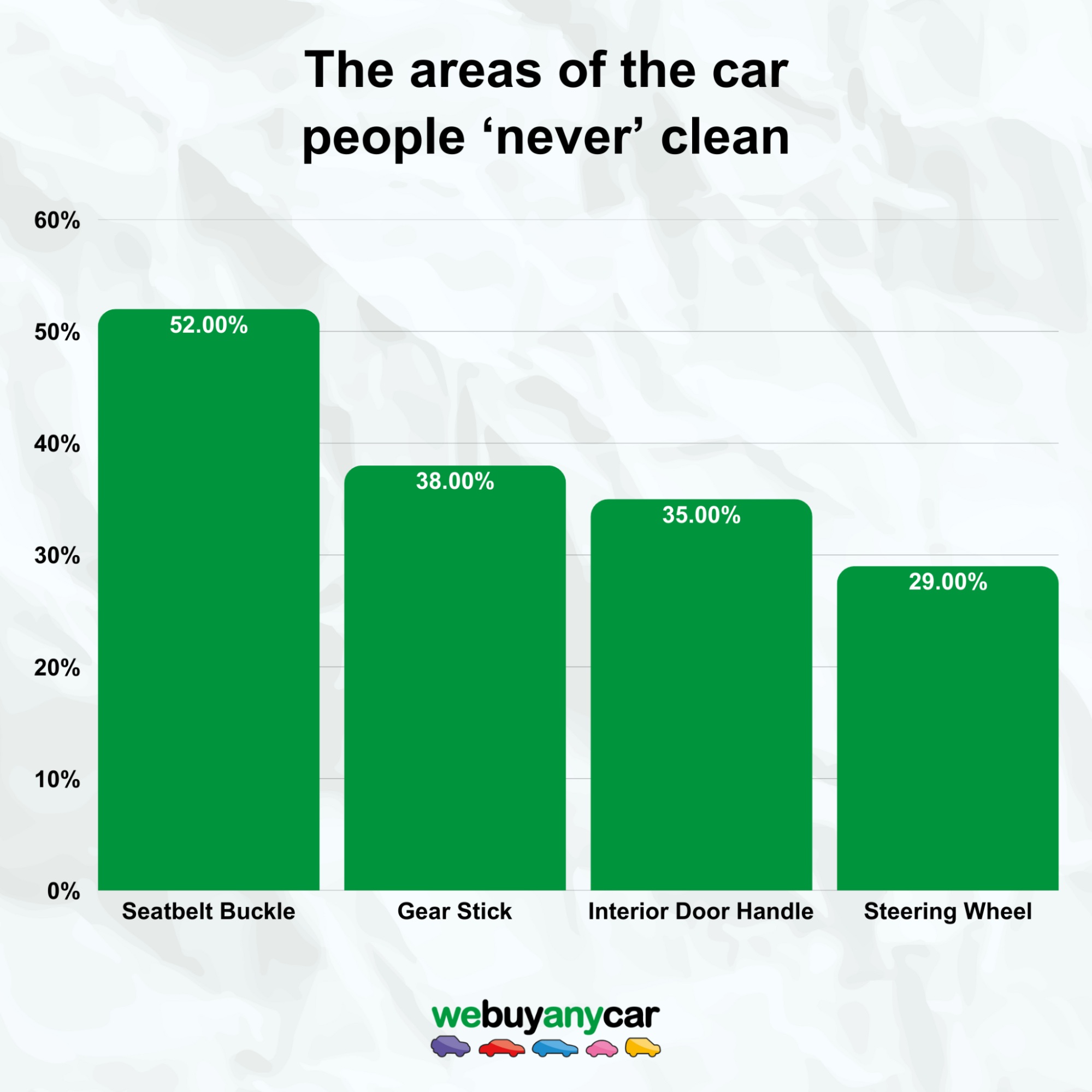
Alongside the bacteria results, we asked the UK public about their car cleaning habits. According to the results, 67% of people clean the exterior of their car once a month or more, while 61% claimed to clean their interiors the same amount.
However, when asked about the specific areas cleaned, many said they ‘never’ sanitised the seatbelt buckle (52%), gear stick (38%), interior door handle (35%), or steering wheel (29%).
The grossest things people have found in their cars
From mould to puddles of dog sick, to maggot-infested food items, the findings are equal parts horrifying and intriguing. Making up some of the main categories of items found in cars were animal-related (30%), food (19%), and mould (13%).
Some have experienced finding dead mice, rats, or pheasants, while others reported stale milk, mouldy food debris, including a 2-month-old scotch egg, and dog or baby poo.
Do we judge people based on car hygiene?
Overall, the answer is a resounding ‘yes’. Approximately 64% of people say they judge others on how clean their car is. Bad smells/odours (31%), dirty or stained seats (25%), and rubbish (18%) are among the common hygiene issues people say make a car seem the dirtiest.
Many are likely to decline the offer of a car ride if yours contains any of the following:
- A bad smell: 62%
- Dirty or stained seats: 50%
- Pet hair: 28%
- Sticky surfaces: 22%
- Food crumbs: 21%
- Rubbish: 19%
Despite admitting that we judge people on the cleanliness of their vehicles, the results show that we’re also aware of how our own motors are perceived. In fact, nearly half (49%) of people have felt embarrassed about how dirty their car is.
Easy tips to keep bacteria numbers low
- Vacuum and wipe down upholstery regularly: Bacillus species usually point to soil or food crumbs building up, especially if you eat in the car.
- A quick wipe-down of surfaces: Micrococcus luteus thrives in dry, dusty places.
- Clean spills properly: Serratia marcescens thrives in moist environments, so it’s important to dry out moisture quickly and check for leaks or condensation. This is also important for yeasts, which can create staining or odours over time.
- Clean the A/C system: Pseudomonas species live in soil and water and love damp spots; think air-con vents, soggy mats, or anything that didn’t dry out properly.
- To prevent mould: Dry the car out, fix leaks, use dehumidifiers if needed, and treat visible mould with antifungal spray. If you’re prone to allergies, mouldy interiors can be a serious problem.
Methodology
We teamed up with a Consultant Microbiologist (BSc Microbiology, University of Nottingham) and swabbed ten used cars, focusing on four key touchpoints:
- Gear stick
- Inside car door handle
- Steering wheel
- Seatbelt buckle
For each surface, we used a sterile swab to collect a sample from a 3 cm² area. The samples were then placed onto agar plates and incubated to allow any microbes to grow into visible colonies.
We measured the results in CFU (Colony Forming Units), which represent the number of living microorganisms capable of forming a colony. To make fair comparisons between different surfaces, we calculated the CFU/cm² by dividing the total CFU count by the 3 cm² swabbing area. This gave us an average bacterial density for each spot we tested.
Survey data based on 1,570 UK respondents in August 2025.







